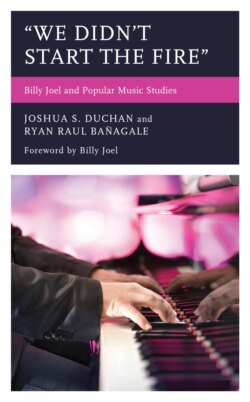Читать книгу “We Didn’t Start the Fire” - Группа авторов - Страница 9
На сайте Литреса книга снята с продажи.
ОглавлениеForeword
By Billy Joel
It’s a little intimidating to think that I’m the subject of a book like this, by a group of scholars, analyzing my music. The most important book I ever had in my life was my mother’s copy of the Fireside Book of Folk Songs by Margaret Bradford Boni.1 I started reading it when I was a kid, looking at the pictures alongside songs like “She’ll Be Comin’ Around the Mountain.” There’s a drawing of a choo-choo train, and a mountain, and a girl in the train. And that got me. I didn’t even know how to read music or play piano at the time. But I would look through the book and make believe that I was playing those songs.
To this day, I think that book greatly influenced the way I write music. It’s a painterly approach, something visual. You can hear it on songs like “Streetlife Serenader.” The left hand is total Debussy. The piano solo has elements of Mussorgsky’s Pictures at an Exhibition. You can also see it in the way the cover of that album, an American scene, was painted like an Edward Hopper piece.2 Of course, not all my songs are quite that impressionistic. Most are pretty literal. But I write the same way I hear. For all my life, starting with the Fireside Book, I’ve been something of a sponge, soaking in lots of different kinds of music.
Although I have a lot of music history in my background, my ear tells me what to do, not my brain. The scholars in this book have a lot more technical knowledge than I do. I’m not trained in music theory or analysis. But to me, music is the primary language. Words come later. I’m not going to be compelled to write a lyric unless there’s a piece of music that moves me, that inspires me. Even as a kid, I would figure out a song by listening to the music first, playing the record over and over again, feeling the rhythm, learning the arrangement, hearing the production. Finally, I’d get to the words. That’s also how I write songs. I work through the music first and then I ask, what is it saying? What is the mood? What does this music make me feel? I suppose that’s a kind of analysis too.
Now, a lot of rock critics would disagree with me. They would say, “No, no, no. A real rock musician is pure and has never received any education. It’s all just native talent.” Well, bullshit. You can’t really express talent unless you have the tools. You’ve got to learn how to play it first, and then you can learn how to write it. The great jazz pianist Oscar Peterson once told me, “Look, if you want to get your left hand to play the way you want, learn to play Gershwin’s ‘The Man I Love’ with your left hand alone.” For me, that opened up new ways of thinking about music. And it’s one example of how a songwriter can explore the rudiments to develop the tools to create something new.
The authors of the chapters in this book take similar approaches, painting my career in broad strokes. Each chapter brings different tools to the analysis of my music, then writes about it, opening up new ways to understand it. They uncover ways of hearing my music beyond what I could have conceived or intended. Garth Brooks did that with his cover of “Shameless,” turning what I believed to be a Jimi Hendrix song into a chart-topping country number. If somebody does something I haven’t thought of, and it’s an improvement on what I did, I’m all in favor of it.
I’ve been asked about legacy and how my songs might be interpreted in the future. Let’s be clear: there are some songs I wrote that, in my opinion, have not aged well and that I don’t think are very good—probably somewhere around 20 percent of my published song catalogue. And with the record company releasing albums and box sets containing demos and alternate takes, I don’t have the opportunity to simply throw away material that I don’t think anyone should hear in a way that folks like Beethoven could. But I have mixed feelings about that. While I don’t like the idea of sharing bits of my own music that should have stayed on the cutting room floor, I also understand that that’s one way we can learn about composers. And I guess I’ve become one of them.
Ultimately, I leave the interpretation of my music to others. I’ve said all I can, in the music and in interviews. I’m flattered that the last few years have seen an increase in interest in my music on the part of musicologists and other scholars, seeking better understandings of my songs and their place in American history and culture. If that all continues, great. And the chapters in this book are a very good place to start.
January 2020
Oyster Bay
NOTES
1. Margaret Bradford Boni, Fireside Book of Folk Songs (New York: Simon & Schuster, 1947).
2. Billy Joel, Streetlife Serenade (Columbia, 1974). The cover, by Brian Hagiwara, is a painting of the corner of Seventh and South Center Streets in San Pedro, California.
